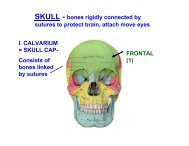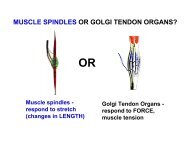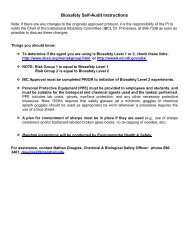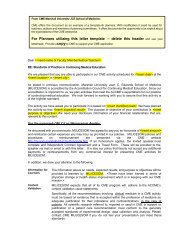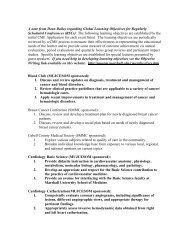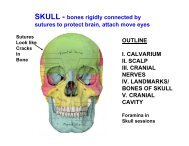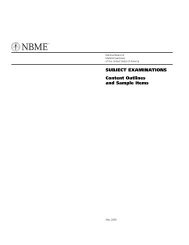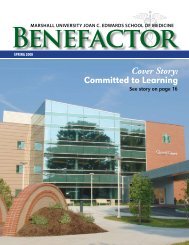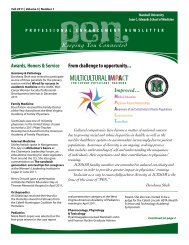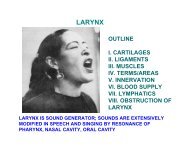FA 5 Progress Report WV-INBRE - Joan C. Edwards School of ...
FA 5 Progress Report WV-INBRE - Joan C. Edwards School of ...
FA 5 Progress Report WV-INBRE - Joan C. Edwards School of ...
- No tags were found...
Create successful ePaper yourself
Turn your PDF publications into a flip-book with our unique Google optimized e-Paper software.
Program Director/Principal Investigator (Last, First, Middle): Rankin, Gary O 47MECHANOTRANSDUCTION, INTRACELLULAR SIGNALING AND VASCULAR BIOLOGY(0022)TYPE:Research Subproject%IDeA $: 5.000% IDeA $: 175,256INVESTIGATOR, DEGREEHarris, Rob PHDBlough, Eric PHDDEPARTMENTBiologyBiological SciencesNON-HOST INSTITUTION: STATE,COUNTRYWest Virginia State University, Wv UsaTotal # human subjects expected for entire study: 0Total # human subjects enrolled to date: 0SUBPROJECT DESCRIPTIONA fundamental problem in biology is to understand how cells are able to sense and respond toenvironment cues. The integration <strong>of</strong> chemical signals such as growth factors and cytokines withmechanical stimuli is not well understood. The place where cascades involved in solid-state (mechanical)signaling and soluble (chemical) signaling converge and the manner in which they interact is no doubtcomplex. This research project is designed to investigate signaling events associated with both chemicaland mechanical stimuli. Cells <strong>of</strong> the vascular system are continuously exposed to the effects <strong>of</strong> mechanicalforces such as stretching and fluid shear stress. These forces, which are created by the pulsatile nature <strong>of</strong>blood flow when the heart contracts and relaxes, have a marked influence on cell structure and function. Theadaptations <strong>of</strong> these cells, including enhanced growth and migration, seem to be important in thepathological conditions that accompany cardiovascular diseases such as atherosclerosis, hypertension,and restenosis. Cardiovascular disease remains a major cause <strong>of</strong> morbidity and mortality in the U.S. and theeconomic and human costs associated with these pathologies are enormous. This has resulted in an intenseresearch interest in the mechanisms which regulate contraction, migration, and growth <strong>of</strong> vascular smoothmuscle cells (VSMC). While it is now clear that mechanical forces imposed on cells <strong>of</strong> the vessel wall areimportant factors in the initiation and progression <strong>of</strong> pathological changes, the molecular mechanismsinvolved in these adaptations are not fully understood. In addition, it is now clear that the basic mechanism <strong>of</strong>smooth muscle contraction can only be explained in light <strong>of</strong> actin remodeling. However, the exact nature <strong>of</strong>cytoskeletal reorganization and the mechanisms regulating these changes are not well known. The overallgoal <strong>of</strong> this project is to elucidate the acute responses in cytoskeletal reorganization that occur duringmechanical stress <strong>of</strong> VSMC and to determine the intracellular signaling mechanisms that are involved.Utilizing molecular approaches combined with fluorescence microscopy, and relying on theprecise changes in cell orientation and actin cytoskeletal reorganization as endpoints for quantitativeassessment <strong>of</strong> responsiveness to mechanical strain, we will evaluate the role <strong>of</strong> various cytoskeletalstructures on the response <strong>of</strong> VSMC to stretch. Further, we will make a systematic determination <strong>of</strong> theeffects <strong>of</strong> various types <strong>of</strong> mechanical stress on activation <strong>of</strong> cell signaling molecules. In addition, we willevaluate the effects <strong>of</strong> resveratrol, a purported cardioprotective molecule, for its potential effects onstretch-induced cell signaling and receptor mediated cellular hypertrophy. The use <strong>of</strong> pharmacologic andmolecular techniques to stabilize, destabilize or down-regulate specific cytoskeletal components isexpected to provide clear answers concerning the role <strong>of</strong> specific components in mechanotransduction andthe cell orientation response. The inhibition or down-regulation <strong>of</strong> specific signaling proteins is expected toprovide information concerning pathways regulating mechanosensing and transduction. The knowledgegained may be useful in the development <strong>of</strong> therapeutic agents regulating mechanotransductionmechanisms contributing to cardiovascular pathologies.SUBPROJECT PROGRESSAmong the changes in gene expression that we have found to be associated with mechanicalstress is the the giant protein titin. The role <strong>of</strong> titin in organizing and stabilizing contractile filamentsin sarcomeres <strong>of</strong> striated muscle is well understood. Titin forms filaments in cardiac and skeletalmuscle that provide elasticity in relaxed cells but limit cell lengthening and as such contribute tooverall stiffness. Since its discovery nearly a decade ago, the function <strong>of</strong> smooth muscle (SM) titinPHS 2590 (Rev. 06/09)Continuation Format Page



